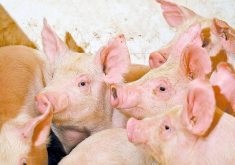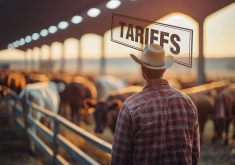Every breeding herd should have output targets such as number of matings and farrowings per week and average numbers born and weaned.
Computerized herd-recording systems have come a long way since they were first developed in the 1980s and with today’s computing power are capable of complex analysis. But many producers don’t look beyond the basic measures of breeding herd performance, such as litter size, farrowing rate and piglet mortality. Some of the programs spit out a lot of irrelevant figures, which can be unhelpful and confusing.
Read Also

Horns aren’t unlocking anytime soon on livestock transport standards
Standards good enough meet the definition of “humane” animal transportation still vary widely between what what industry wants, what animal rights advocates want and, between the two, what federal regulators decide is good enough.
Learning to drill down into herd data can not only be very interesting but also profitable. Here are a few tips on getting the best from your records.
Identify problem areas first
This may seem obvious, but often problem areas are hidden by lots of other data. First, focus on the basics of farrowing rate, return rate, litter size, piglet mortality, litters per sow per year and pigs weaned per sow per year. Look at trends – have returns to service increased in the last while? If so, look at when those returns occurred relative to time of breeding, which will give a clue as to the cause.
One of my favourite reports is a returns analysis because it shows visually what is going on. Twothirds of returns should be regular, that is at 18-24 days. Irregular returns should be mainly prior to 56 days. Sometimes I see returns being missed and sows identified as non-pregnant when pregnancy tested, which will show as late returns. Also, if regular returns are being missed at 18-24 days, there will be a little spike in returns in the 42-day region. Identifying what is going on will enable quick remedial action to be taken.
Look for potential problems
Although production may be great today, there may be potential problems that records can identify. Often these are related to herd structure and this is a particular issue currently because many herds have failed to maintain the correct replacement rates due to poor economic conditions. An aging parity structure will result in higher stillbirths and piglet mortality, coupled with more health and fertility problems, resulting in reduced herd output.
Worse still, getting the correct parity structure back takes at least three years. Picking up deviations from the ideal parity profile early enables corrective action to be taken quickly, and long-term damage to be minimized.
One indicator that I like to look at is average weaning-to-service (W-S) interval by parity. This parameter is closely linked to subsequent performance and can therefore provide an early warning of reduced farrowing rate or litter size. For example, if lactation feed intake was reduced due to unpalatable feed ingredients, it would quickly impact W-S interval and raise the red flag. If this was missed, it could be months before a problem was identified.
W-S interval is also a very good measure of the general state of the breeding herd. If I see an average across all parities of five days in herds where natural mating is used, or 5.5 days where AI is used, it’s a very clear indication that management is good in the herd.
I also look at the percentage of sows bred by seven days after weaning, which should be about 95 per cent with these low W-S intervals. The W-S interval for first-parity sows is another valuable indicator. It is normal for this to be about one day longer than for parity-three sows and above. Parity-two sows may also show a slightly higher interval (0.2 to 0.5 days).
If the difference is more, it will be reducing productivity. This is often expressed as a reduction in litter size from parity one to parity two. Because subsequent litter size is correlated to gilt and second litter size, it could result in a 0.5 to 1.0 reduction in pigs born per litter from parity three onwards.
Look at output related figures
Every breeding herd should have output targets such as number of matings and farrowings per week and average numbers born and weaned. Maintaining target output is essential in order to minimize production costs. Pigs weaned per sow is meaningless if the facility is not operating to capacity. Targets for all the output-related parameters should be a key part of performance monitoring, with the objective of transferring the correct number of weaned pigs into the nursery each week and every week.
Benchmark your production
Benchmarking simply involves knowing how well you are doing relative to similar businesses. Its value is in being to identify strong and weak areas, in particular opportunities to improve efficiency and profitability. Unfortunately, there are few good reference sources in Canada, but some veterinary groups have inhouse benchmarking programs and genetics suppliers often have extensive customer data. Another good source is international benchmarking data, especially from Europe and the U.S. Of course, such data needs to be interpreted in relation to one’s own figures and each herd needs to set its own targets for each key performance parameter. Targets must be also regularly reviewed and updated to keep them challenging but not impossible.
Look for profit opportunities
Physical records are one thing, but linking them to financial data is often a challenge. However, in today’s economic environment, it is essential to assess the impact on the bottom line of productivity improvements, especially where they have a cost. Herd records can help to identify profit opportunities as well as measure the impact of changes to management aimed at improving efficiency.
Bernie Peet is president of Pork Chain Consulting of Lacombe, Alberta, and editor of Western Hog Journal














